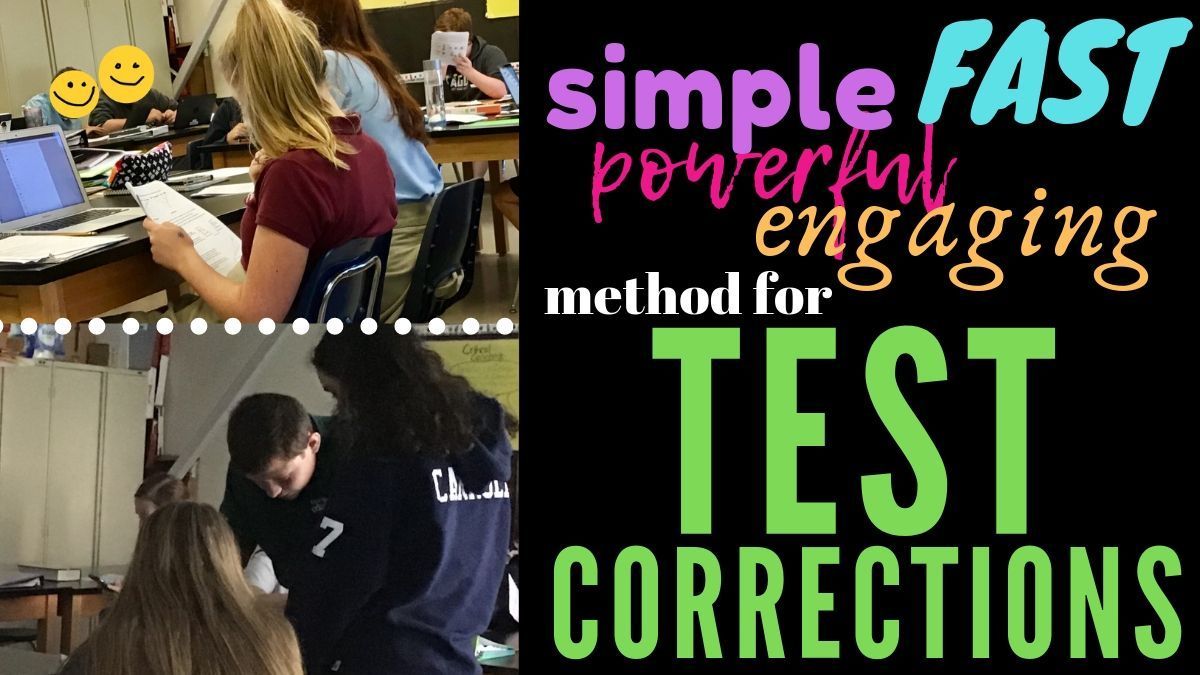We all want our students to learn from their mistakes. Tests are not just a grade, but a measure of where student understanding is. We want to help fill in the gaps, which usually includes going over the test or test corrections.
But what is the best way to do test corrections? I was searching for a way that truly helped students learn from their mistakes, but did not take up a lot of time. I needed a test correction method that was meaningful, and motivated even hard-to-motivate students.
And I found it!
At one point or another, all teachers have gone the route of going over each test question, or perhaps just the most-missed questions. This is a fast way to get through all of the test content. However, even the student with the longest attention span will begin zoning out at question three.
Offering the chance to do test corrections is a great way to engage students individually in learning from what they got wrong. The supreme goal is for students to know why one answer is incorrect, and then truly understand what the right answer is.
I have tried so many methods for test corrections. Each one has pros and cons.
For all of their wrong answers, students provide the right answer: Yes the correct answer passes through their brain, but this method does not encourage students to truly learn, it is easy to find the right answer (ask a friend) but not process why it is right.
For all of their wrong answers, students write the correct answer and explain WHY it is correct This method is great for student understanding. It drives kids to go into their notes or collaborate so that they can produce the answer. I used this method for a long time, but I found that the students who needed test corrections most, often would not complete them. It takes a long time, and a lot of effort, especially if students have missed a lot of questions. this takes a long time to complete.
Besides that, it takes a long time to grade these corrections! The corrections must be correct – and it is the teacher’s job to be sure of that!
So what is the answer? A method that is relatively fast, but packed with real learning, that motivates students to complete the test corrections and rewards them for their work?
Here is the test corrections method I have liked the most:
Students take the test again – with a friend! Let me explain.
BEFORE they get their test back, students work in pairs to re-take the whole test.
They are able to use their notes, text book etc. Instead of the teacher telling them the right answer, they must dig into their resources to find the right answer on their own!
There must be some motivation to re-take the test. For my honors and AP students, the original test is worth 75% and the re-take is worth 25%. For academic students, it is 50/50. Or consider making the re-take into a separate quiz grade. The reward of a good grade is key to motivating students to take this re-take seriously.
Because they have not gotten their test back yet, students do not know which questions they got right or wrong. I do not even let them know their test score!
This is so hard for them, they want to know what they got so badly! But I want them to really get into the assignment and do their best. If they find out they got a 90, and they are happy with that, the re-take will feel more like busywork, rather than an opportunity to earn a better grade.
Without fail, I get the question ‘what if I do worse on the re-take? Will it hurt my grade?” The answer is “YES! So do your best!”
The only exception to this rule (for my classes) is if a student gets a 100 on the test, and is clearly working hard on the re-test, they keep the 100. Working with a partner is a give and take, and sometimes a strong willed partner can push hard enough for a wrong answer to be chosen!
I also encourage them saying ‘Of course you will do better on this re-take – you have your notes, your partner, and you have me to help! You got this!’
Each question is seen as important and should be discussed with a partner and/or looked up in their notes. Every time we do test corrections, I am still amazed at how serious and focused everyone is!
There are so many great conversations about content – students recalling when they learned something, looking for it in their notes, discussing the merits of one answer over another, explaining to each other why they think a particular answer is correct or incorrect – awesome!
While I do allow some students to work alone, I think this test correction method works much better when students have a partner to collaborate with. Taking the information from their own brain and bouncing it off of someone else’s ideas and thoughts really helps their understanding. Students also have a way of explaining things differently, in a way that their partner may understand a concept for the first time! Excellent!
Tips for Test Corrections
All of my tests are done on Google Forms. This makes it really easy for students to re-take a test. I simply make a copy of the original! Google forms provides data right away about how students have performed on the test corrections (re-take) so that you can give feedback right away on misconceptions.
If the test is paper (for multiple choice tests) you can still use Google Forms! Simply make a form with the test question numbers (1, 2, 3) and answer choices (A-D) but you do not have to write in the actual question or answers! Mark the right answers on the Google Form, and it works like a scan-tron that grades itself!
It is best to have students do test corrections as soon as possible after the test. They are already thinking about the questions and interested in the right answers. Also, they are able to move through the re-test more quickly because they remember the questions, what answer they choose, and why they choose it.
Which reminds me of another tip – set a timer! The amount of time depends on your students, but I usually give about a minute per question. It’s helpful to put the timer on the board so everyone can see how much time is left. The timer helps a lot for keeping students focus all the way to the end!
If using google forms, wait until everyone is finished before releasing the test correction scores. If they get them back right away, I have found that early finishers are pressured to share correct answers with students who have not submitted yet!
Or, if you want to give your students the thrill of instant feedback (which they crave), consider adjusting the settings so that they receive their score right away, but do not know which questions they missed.
If time allows, I go over the questions from the re-take that the class still struggled with on the same day. There are usually just three or four on a 50 question test. This data is available right away with google forms!
Students are much more into going over those few test questions if they have not yet gotten back their test, or re-test. They are still curious about those questions they debated over, and are interested in the right answer. When you get to that question that they discussed for 10 minutes and went back and forth on, they are at the edge of their seats to hear the correct answer!
It is helpful to have both partners turn in just one re-take. This cuts your grading in half, and helps to ensure that pairs are truly collaborating and not just doing their own thing next to each other.
Depending on the class, sometimes students are allowed to choose who they want to work with, and sometimes partners are assigned. It is important that both students in the pair are about equal in their understanding of the topic.
If a A+ student pairs with a D student, the D student will often sit back and allow A+ to answer all the questions without offering their own input. In fact, I have found that some Ds seek out As hoping for a free ride to a better grade!

Differentiation:
There are a few ways to adjust this technique for your students.
Some of my academic kids get burned out near the end of a 50 question test. Instead of doing it all at once, it helps to break up the test corrections into three days, with a third of the questions each day.
This can still be done with google forms. One way is to adjust the settings so that students can go back and edit the form. Be sure to have them save their URL by copying it and emailing it to themselves.
A more simple way (for the students) is to copy the test form three times, and in each form only keeping a third of the questions, deleting the rest. For example, for the Day 1 section, keep questions 1-15 and delete question 16-50. Then for the Day 2 form, delete question 1-15, keep questions 16-30, and delete questions 31-50, and so on.
Also, consider compiling only the most missed test questions for the re-take, or eliminating the questions that everyone (or almost everyone) got correct. Again, this is easy to do with google forms. Make a copy of the test, then scroll through your results from the test and delete (from the copy) the questions that everyone did well on. This can save a lot of time, and students know that every question left on the re-test is one to take seriously because the class as a whole struggled on it.
“Can the test corrections hurt my grade if I do worse on the re-take?” You will hear it so many times! I mentioned earlier that only 100s keep their 100. You can make this cut off wherever you would like. For academic students, you may choose to say that any grade over a 90, or over an 80 will keep their score even if they do worse on the test corrections.
One other way to do it is to offer extra credit for doing well on test corrections. Maybe students get 5 extra credit points for scoring over a 90, and 3 extra credit points for scoring over an 80. This puts less pressure on students because there will be no way to hurt their grade.
Does the teacher offer help to answer the questions, or not? That again depends on the group of students. For my AP kids, they get no direct help from me. That does not mean I don’t interact!
I walk around and point out ideas they may have missed, play devil’s advocate to draw out the pros and cons of each answer choice, and generally get them thinking if they get stuck – but I do not provide the right answer directly.
My academic class is a bit different. Some students will need more help and encouragement. If they ask for help on a question, I will get them to narrow it down to their top two possibilities, tell me why they choose those, and then I will guide them with questions to the right answer.
I am also happy to (quietly) confirm a correct answer to provide that instant feedback they crave to keep spirits high and motivated as they tackle the test corrections.
These interactions with your students are rich and meaningful. You will be amazed at how focused and determined your students will be to get the right answers. And the journey to those correct answers is paved with collaboration, deep thinking, and learning – awesome!




